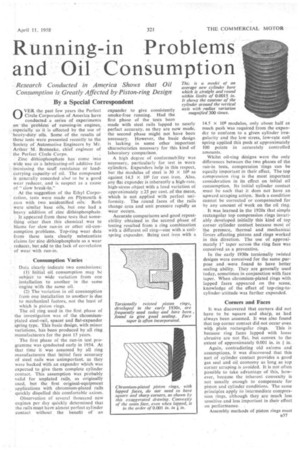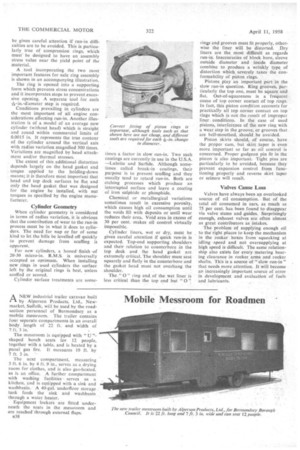Running-in Problems and Oil Consumption
Page 71

Page 72

If you've noticed an error in this article please click here to report it so we can fix it.
Research Conducted in America Shows that Oil Consumption is Greatly Affected by-Piston-ring Design By a Special Correspondent
OVER the past few years the Perfect Circle Corporation of America have conducted a series of experiments on the problem of running-in engines, especially as it is affected by the use of heavy-dutyoils. Some of the results of these tests vere presented recently to the Society of 'Automotive Engineers by Mr. Arthur • M. Brenneke, chief engineer of the Perfect Circle Corpn, Zinc dithiophoSphate has come into wide use acs .a lubricating-oil additive for increasing the Scuff resistance or loadcarrying capacity•of oil. The compound is generally conceded alsd to he a good wear reducer, and is suspect as a cause of "slow break-in."
At the suggestion of the Ethyl Corporatiort, tests were made on Plymouth 6 cars with two unidentified oils: Both were similar base oils, but one had a heavy addition of zinc dithiophosphate: appeared from these tests that something other than this chemical was to blame for slow run-in or other oil-consumption problems. Top-ring wear data from these tests clearly substantiate claims for zinc dithiophosphate as a wear reducer, but add to the lack of correlation of wearwith run-in.
Consumption Varies
Data clearly indicate two conclusions: (1) Initial oil. consumption may be subject' to wide variation from one installation to another. in the same . engine with the same oil.
(2) The 'variation in oil consumption from one installation to another Is due to mechanical factors, not the least of which is piston rings.
The oil ring used in the first phase of the investigation was of the chromiumplated steel-rail, spacer and flat-expander spring type. This basic design, with minor variations, has been produced by all ring manufacturers for the past 15 years.
The first phase of the run-in test programme was eponducted early in 1954. At that time it was assumed by all ring manufacturers that initial face accuracy of steel rails was unimportant, as they were backed with an expander which was expected to give them complete cylinder contact. This assumption was probably valid for unplated rails, as originally used, but the first original-equipment applications with chromium-plated rails quickly dispelled this comfortable axiom.
Observation or several thousand new engines per day quickly determined that the rails must have almost perfect cylinder contact without the benefit of an
expander to give consistently smoke-free running. Had the first phase of the tests been made with steel rails lapped to nearly perfect accuracy, as they are now made, the second phase might not have been necessary. However, the basic design is lacking in some other important characteristics necessary for this kind of laboratory comparison.
A high degree of conformability was necessary, particularly for test in worn cylinders. Expanders help in this respect, but the modulus of steel is 30 X 106 as against 14.5 x 106 for cast iron. Also, any flat expander is inherently a high-rate, high-stress object with a load variation of approximately ±-25 per cent, of the mean, which is not applied with perfect uniformity. The round faces of the rails change area and unit pressure rapidly as wear occurs.
Accurate comparisons and good repeatability obtained in the second phase of testing resulted from a ring combination with a different oil ring,--.one with a coilspring expander, Being cast. iron with a 14.5 x 106 modulus, only about half as much push was required from the expander to conform to a given cylinder irregularity and the low stress, low-rate coil spring applied this push at approximately 100 points in accurately controlled amounts.
Whilst oil-ring designs were the only differences between the two phases of the run-in tests, compression rings can be equally important in their effect. The top compression ring is the most important consideration in its effect on initial oil consumption. Its initial cylinder contact must he such that it does not have an upward scraping action.. Such a condition cannot be corrected.or compensated for by any amount of work on the oil ring.
It was learned in the 1920s that simple rectangular top compression rings invariably Aleveloped initially this kind of top corner cylinder contact because most of the pressure, thermal and mechanical a)rces affecting pistons and rings worked in this direction. The use of approximately 1° taper across the ring face was conceived as a preventive. .
In the early 1930s torsionally twisted designs were conceived for the same purpose and -were found to have better sealing ability. They are generally used today, sometimes in conjunction with face taper. When chromium-plated rings with lapped faces appeared on the scene, knowledge of the effect of top-ring-tocylinderattitude was further expanded.
Corners and Faces
It was discovered that corners did not have to be square and sharp, as had always been assumed. It was also found that top corner contact did not occur even wit plain rectangular rings. This is because ring faces lapped with loose abrasive are not flat, but convex to the extent of approximately 0.001 in. in in.
Again, contradicting old axioms and assumptions, it was discovered that this sort of cylinder contact provides a good gas seal and oil economy as long as top corner scraping is avoided. It is not often possible to take advantage of this, however, because the inherent convexity is not usually enough to compensate for piston and cylinder conditions. The same principles apply to intermediate compression rings, although they are much less sensitive and less important in their effect on performance. .
Assembly methods of piston rings must B37 be given careful attention if run-in difficulties are to be avoided. This is particularly true of compression rings, which must' be designed to have an assembly stress value near the yield point of the material.
A tool incorporating the two most important features for safe ring assembly is shown in an accompanying illustration.
The ring is opened into a supporting form which prevents stress concentrations and it incorporates stops to prevent excessive opening. A separate tool for each --in.-diameter step is required.
Conditions prevailing in cylinders are the most important of all engine considerations affecting run-in, Another illustration is of a model of an average new cylinder (without head) which is straight and round within commercial limits of 0.0015 in. It represents the true contour of the cylinder around the vertical axis with radius variation magnified 300 times. Variations are magnified by head attachment and/or thermal stresses.
The extent of this additional distortion depends largely on the head gasket and torque applied to the holding-down means; it is therefore most important that head and top deck surfaces be flat and only the head gasket that was designed for the engine be installed, with nut torques as specified by the engine manufacturer.
Cylinder Geometry
When cylinder geometry is considered in terms of radius variation, it is obvious that the contribution of wear to the run-in process must be in what it does to cylinders. The need for nap or fur of some kind to let the hills be levelled off quickly to prevent damage from scuffing is apparent.
For new cylinders, a honed' finish -of 20-30 micro-in. R.M.S. is universally accepted as optimum. When installing new rings in used cylinders the surface left by the original rings is best, unless scuffed or scored.
Cylinder surface treatments are some
times a factor in slow run-in. Two such coatings are currently in use in the U.S.A. —Lubrite and Surfide. Although sometimes called break-in coatings, their purpose is to prevent scuffing and they usually tend to retard run-in. Both are etching processes which produce an interrupted surface and leave a coating of iron sulphide or phosphide.
Chemical or metallurgical variations sometimes result in excessive porosity, which causes high oil consumption until the voids fill with deposits or until wear reduces their area. Void area in excess of 30 per cent, makes oil control virtually impossible.
Cylinder liners, wet or dry, must be given careful attention if quick run-in is expected. Top-end supporting shoulders and their relation to counterbore in the top deck and the head gasket arc extremely critical. The shoulder must seat squarely and flatly in the counterbore and the gasket head must not overhang the shoulder.
The " 0 " ring end of the wet liner is less critical than the top end but " 7
rings and grooves must fit properly, other:wise the liner will be distorted. Dry liners are the most difficult as regards run-in. Inaccuracies of block bore, sleeve outside diameter and inside diameter combine to produce a wrinkly type of distortion which severely taxes the conformability of piston rings.
Pistons play an important part in the slow run-in question. Ring grooves, particularly the top one, must be square and flat. Out-of-squareness is a frequent cause of top corner contact of top rings. In fact, this piston condition accounts for practically all top corner contact on top rings which is not the result of improper liner conditions. In the case of used pistons, interference of the new ring with a wear step in the groove, or grooves that are bell-mouthed, should be avoided.
Piston skirts s,hould, of course, have the proper cam, but skirt taper is even more important so far as oil control is concerned. Proper gudgeon pin fit in the piston is also important. Tight pins are particularly, to be avoided, because they prevent expansion control from functioning properly and reverse skirt taper or seizure will result.
Valves Cause Loss
Valves have always been an overlooked source of oil consumption. But of the total oil consumed in cars, as much as 75 per cent. has been found to disappear via valve stems and .guides. Surprisingly enough, exhaust valves are often almost as great contributors as intakes.
The problem •of supplying enough oil to the right places to keep the mechanism in the rocker boxes from 'squeaking at idling speed and not oversupplying at high speed is difficult, The same relationship also exists for every metering bearing clearance in rocker arms and rocker shafts. This is a source of " slow run-in '• that needs more attention. It will become an increasingly important source of error in development and evaluation of fuels and lubricants.




















































































































